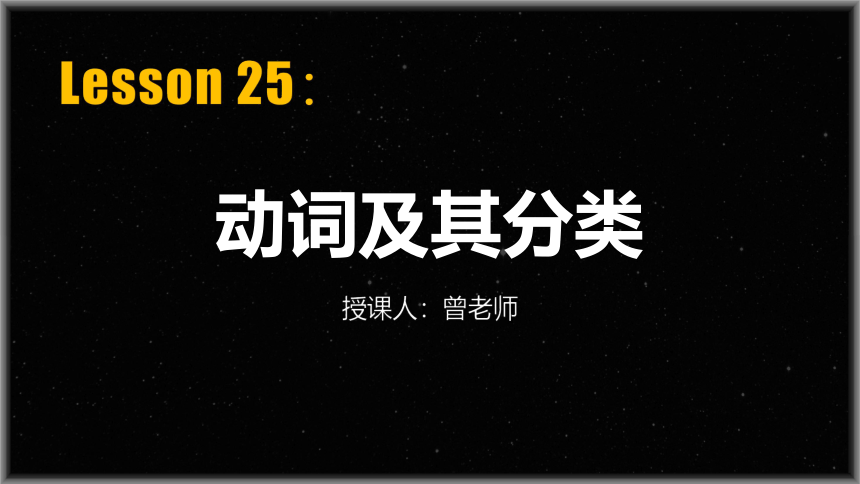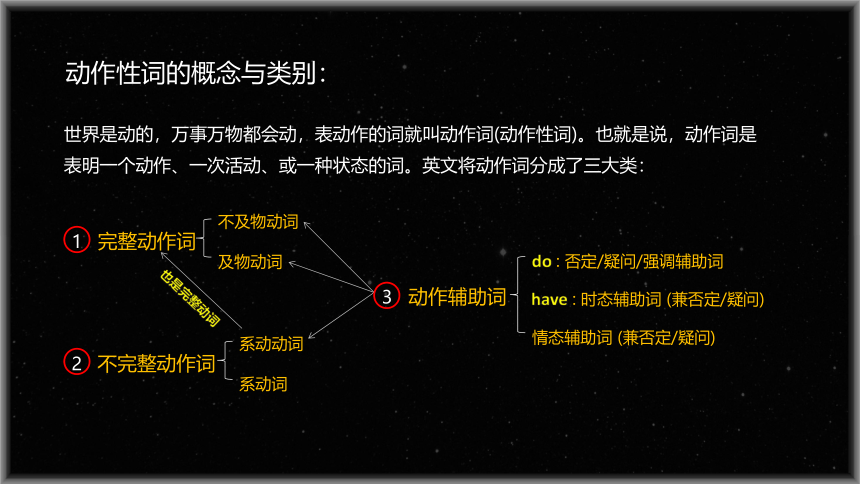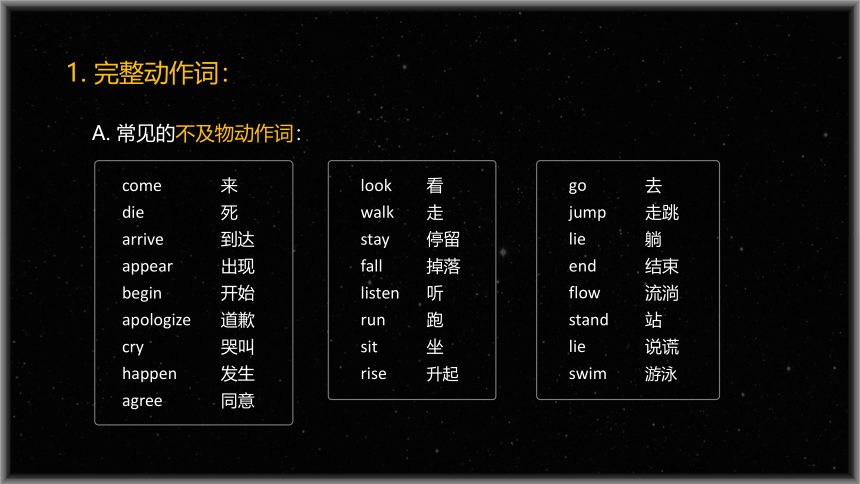L25-动词的类别 初中英语词性句法新讲课件
文档属性
| 名称 | L25-动词的类别 初中英语词性句法新讲课件 |  | |
| 格式 | ppt | ||
| 文件大小 | 994.0KB | ||
| 资源类型 | 试卷 | ||
| 版本资源 | 通用版 | ||
| 科目 | 英语 | ||
| 更新时间 | 2022-04-11 09:59:44 | ||
图片预览





文档简介
(共10张PPT)
动词及其分类
Lesson 25:
授课人:曾老师
动作性词的概念与类别:
世界是动的,万事万物都会动,表动作的词就叫动作词(动作性词)。也就是说,动作词是
表明一个动作、一次活动、或一种状态的词。英文将动作词分成了三大类:
不及物动词
及物动词
do : 否定/疑问/强调辅助词
have : 时态辅助词 (兼否定/疑问)
情态辅助词 (兼否定/疑问)
系动动词
系动词
也是完整动词
1 完整动作词
2 不完整动作词
3 动作辅助词
1. 完整动作词:
表示一个完整的动作,可以独立充当谓语。比如:talk, sing, dance, walk, run, jump, …
1). 不及物动作词:
不及物动作词是动作词中的完整动作词,可以独立充当谓语。比如:
Class begins. I apologize. She listened carefully for a while.
2). 及物动作词:
及物动作词虽然动作明确可当谓语,但它必须要有内容/对象后意思才完整。比如:
His father receives a letter. Miss Zhou teaches us English.
A. 常见的不及物动作词:
come
die
arrive
appear
begin
apologize
cry
happen
agree
来
死
到达
出现
开始
道歉
哭叫
发生
同意
look
walk
stay
fall
listen
run
sit
rise
看
走
停留
掉落
听
跑
坐
升起
go
jump
lie
end
flow
stand
lie
swim
去
走跳
躺
结束
流淌
站
说谎
游泳
1. 完整动作词:
B. 常见的单宾语及物动作词:
receive
accept
forget
enjoy
lose
put
defeat
cover
bury
catch
收到…
接受…
忘记…
乐享…
失去…
放置…
打败…
覆盖…
埋葬…
抓住/赶上…
make
clean
discover
guess
search
call
interest
excite
please
surprise
做出/造出…
打扫/清洁…
发现…
猜测…
搜索寻找…
打电话给/叫…
使…感兴趣/吸引…的注意力
使…激动
使…高兴/愉悦
使…惊讶
1. 完整动作词:
C. 常见的双宾语及物动作词 (又可当作单宾语动词用):
give (sb. sth.)
hand (sb. sth.)
ask (sb. sth.)
pass (sb. sth.)
pay (sb. sth.)
post (sb. sth.)
return (sb. sth.)
tell (sb. sth.)
show (sb. sth.)
给 (某人) (某物)
递给 (某人) (某物)
问 (某人) (某事)
传送给 (某人) (某物)
付给 (某人) (钱/物)
邮寄给 (某人) (某物)
返还 (某人) (某物)
告诉 (某人) (某事)
给 (某人) 看 (某事)
promise (sb. sth.)
read (sb. sth.)
sell (sb. sth.)
teach (sb. sth.)
get (sb. sth.)
take (sb. sth.)
leave (sb. sth.)
bring (sb. sth.)
write (sb. sth.)
答应 (某人) (某事/物)
读给 (某人) (某内容)
卖给 (某人) (某物)
教 (某人) (某内容)
给 (某人) 搞到 (某物)
给 (某人) 带去 (某物)
留给 (某人) (某物)
给 (某人) 带来 (某物)
写给 (某人) (某内容)
1. 完整动作词:
同样是及物动词,在不同的结构中意思并不相同。比如:
注意及物动词的不同用法:
I get a lot of enjoyment from music.
Go and get me a pen please.
I don’t remember my first day at school.
Remember me to one who lives there.
We found a great new restaurant near the office.
Tell him to find me an acre of land.
If you ask someone to remember you to a person who you have not seen for a long time, you are asking them to pass your greetings on to that person.
及物动词使用的二种情况:
1. 该动作是针对什么内容
2. 做这个动作是为谁而做
D. 常见的带宾补及物动作词:
有些动作词带宾语时,需要在宾语后再加一个补足语意思才能完整。
我们把这类动作词叫做带宾补动词。比如:
1. 完整动作词:
Tom finds his answer wrong.
Please get everything ready.
We call him John.
They ask us to run fast.
My parents have me clean my own room.
Take it easy.
4. 不完整动作词:
不完整动作词不表示一个完整的动作,不可以独立充当谓语。它只是个连接词,将
“主语对象”与“表述语”连接起来。“连接词+表述语”合起来称为“系表结构”谓语。
1). 系动词:静态表述 (is/am/are, was/were)
2). 系动动词:静转动表述
主要是用于介绍说明,属于纯静态表述。比如:
He is an honest man. Those pictures are very beautiful. He is from America.
静与动不是绝对的,它们之间可以相互转换。系动动词将静态表述动作化。比如:
The leaves turn green. His dreams come true. You look worried.
5. 动作辅助词:
动作辅助词无法单独使用,它是完整动作词(包括系动动词)的辅助词。帮助完整动作词
实现靠自己无法实现的各类功能。从功能上来讲,有三类:
1). do : 否定/疑问/强调辅助词
He doesn’t know the answer. Does he know the answer He does know the answer.
2). have : 时态辅助词 (兼否定/疑问)
He has left his city. We haven’t heard the news. Have they got the news
3). 情态辅助词 (兼否定/疑问)
It can be quite cold here in winter. She can’t sing it in English. Can you swim
动词及其分类
Lesson 25:
授课人:曾老师
动作性词的概念与类别:
世界是动的,万事万物都会动,表动作的词就叫动作词(动作性词)。也就是说,动作词是
表明一个动作、一次活动、或一种状态的词。英文将动作词分成了三大类:
不及物动词
及物动词
do : 否定/疑问/强调辅助词
have : 时态辅助词 (兼否定/疑问)
情态辅助词 (兼否定/疑问)
系动动词
系动词
也是完整动词
1 完整动作词
2 不完整动作词
3 动作辅助词
1. 完整动作词:
表示一个完整的动作,可以独立充当谓语。比如:talk, sing, dance, walk, run, jump, …
1). 不及物动作词:
不及物动作词是动作词中的完整动作词,可以独立充当谓语。比如:
Class begins. I apologize. She listened carefully for a while.
2). 及物动作词:
及物动作词虽然动作明确可当谓语,但它必须要有内容/对象后意思才完整。比如:
His father receives a letter. Miss Zhou teaches us English.
A. 常见的不及物动作词:
come
die
arrive
appear
begin
apologize
cry
happen
agree
来
死
到达
出现
开始
道歉
哭叫
发生
同意
look
walk
stay
fall
listen
run
sit
rise
看
走
停留
掉落
听
跑
坐
升起
go
jump
lie
end
flow
stand
lie
swim
去
走跳
躺
结束
流淌
站
说谎
游泳
1. 完整动作词:
B. 常见的单宾语及物动作词:
receive
accept
forget
enjoy
lose
put
defeat
cover
bury
catch
收到…
接受…
忘记…
乐享…
失去…
放置…
打败…
覆盖…
埋葬…
抓住/赶上…
make
clean
discover
guess
search
call
interest
excite
please
surprise
做出/造出…
打扫/清洁…
发现…
猜测…
搜索寻找…
打电话给/叫…
使…感兴趣/吸引…的注意力
使…激动
使…高兴/愉悦
使…惊讶
1. 完整动作词:
C. 常见的双宾语及物动作词 (又可当作单宾语动词用):
give (sb. sth.)
hand (sb. sth.)
ask (sb. sth.)
pass (sb. sth.)
pay (sb. sth.)
post (sb. sth.)
return (sb. sth.)
tell (sb. sth.)
show (sb. sth.)
给 (某人) (某物)
递给 (某人) (某物)
问 (某人) (某事)
传送给 (某人) (某物)
付给 (某人) (钱/物)
邮寄给 (某人) (某物)
返还 (某人) (某物)
告诉 (某人) (某事)
给 (某人) 看 (某事)
promise (sb. sth.)
read (sb. sth.)
sell (sb. sth.)
teach (sb. sth.)
get (sb. sth.)
take (sb. sth.)
leave (sb. sth.)
bring (sb. sth.)
write (sb. sth.)
答应 (某人) (某事/物)
读给 (某人) (某内容)
卖给 (某人) (某物)
教 (某人) (某内容)
给 (某人) 搞到 (某物)
给 (某人) 带去 (某物)
留给 (某人) (某物)
给 (某人) 带来 (某物)
写给 (某人) (某内容)
1. 完整动作词:
同样是及物动词,在不同的结构中意思并不相同。比如:
注意及物动词的不同用法:
I get a lot of enjoyment from music.
Go and get me a pen please.
I don’t remember my first day at school.
Remember me to one who lives there.
We found a great new restaurant near the office.
Tell him to find me an acre of land.
If you ask someone to remember you to a person who you have not seen for a long time, you are asking them to pass your greetings on to that person.
及物动词使用的二种情况:
1. 该动作是针对什么内容
2. 做这个动作是为谁而做
D. 常见的带宾补及物动作词:
有些动作词带宾语时,需要在宾语后再加一个补足语意思才能完整。
我们把这类动作词叫做带宾补动词。比如:
1. 完整动作词:
Tom finds his answer wrong.
Please get everything ready.
We call him John.
They ask us to run fast.
My parents have me clean my own room.
Take it easy.
4. 不完整动作词:
不完整动作词不表示一个完整的动作,不可以独立充当谓语。它只是个连接词,将
“主语对象”与“表述语”连接起来。“连接词+表述语”合起来称为“系表结构”谓语。
1). 系动词:静态表述 (is/am/are, was/were)
2). 系动动词:静转动表述
主要是用于介绍说明,属于纯静态表述。比如:
He is an honest man. Those pictures are very beautiful. He is from America.
静与动不是绝对的,它们之间可以相互转换。系动动词将静态表述动作化。比如:
The leaves turn green. His dreams come true. You look worried.
5. 动作辅助词:
动作辅助词无法单独使用,它是完整动作词(包括系动动词)的辅助词。帮助完整动作词
实现靠自己无法实现的各类功能。从功能上来讲,有三类:
1). do : 否定/疑问/强调辅助词
He doesn’t know the answer. Does he know the answer He does know the answer.
2). have : 时态辅助词 (兼否定/疑问)
He has left his city. We haven’t heard the news. Have they got the news
3). 情态辅助词 (兼否定/疑问)
It can be quite cold here in winter. She can’t sing it in English. Can you swim
同课章节目录
- 词法
- 名词
- 动词和动词短语
- 动词语态
- 动词时态
- 助动词和情态动词
- 非谓语动词
- 冠词
- 代词
- 数词和量词
- 形容词副词及其比较等级
- 介词和介词短语
- 连词和感叹词
- 构词法
- 相似、相近词比较
- 句法
- 陈述句
- 一般疑问句和否定疑问句
- 特殊疑问句及选择疑问句
- 反意疑问句
- 存在句(There be句型)
- 宾语从句
- 定语从句
- 状语从句
- 主谓一致问题
- 简单句
- 并列句
- 复合句
- 主谓一致
- 主、表语从句
- 名词性从句
- 直接引语和间接引语
- 虚拟语气
- 感叹句
- 强调句
- 倒装句
- 祈使句
- 句子的成分
- 句子的分类
- 题型专区
- 单项选择部分
- 易错题
- 完形填空
- 阅读理解
- 词汇练习
- 听说训练
- 句型转换
- 补全对话
- 短文改错
- 翻译
- 书面表达
- 任务型阅读
- 语法填空
- 其他资料
